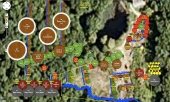My club has been trying to get this
project off the ground for the longest time. We've been given a fairly remote spot on our campus, about half a mile from the nearest running
water. We have a roughly 115'x77' plot(see attachment), with a small
pond in the middle and some oaks at a guestimated height of 50ft (I suck at measuring by eye) directly to the south. Last year's club invested heavily into the soil and it shows, now incredibly rich, loamy, and tilthy. We weeded the place of vines that sprung up over summer, and a month later, a lush meadow replaced it. I'm not sure offhand what the pH is, but I'm pretty sure it's fairly neutral (will find this out soon), but I think we can amend this
I was thinking of doing the U-shaped design I saw in
Gaia's Garden (originally from How to make a Forest Garden), so I was thinking the semi-standard
trees would take up the north ~25ft, dwarfs taking up the next 15-20ft, and so on, with small veggie beds around the
pond, perhaps in a mandala pattern. I want to build up a slight slope to direct the water either towards the pond or to some catchment, so we'd only have to water with a pitcher, if that.
What trees would be best to guild in this small area so that we can get a varied harvest with minimal input? Could someone give an example of a guild that would work well here, and how much space it takes up?
One thing I haven't grasped, though I now how a guild works, I don't know how all the plants relate spatially. Recommended spacing for say, an orange tree is 20ft in an orchard, if I recall. So is everything in a guild supposed to be outside the 20ft, or within it?
Regarding paths, could I fit a mandala pattern, with a small flower bed around the pond and an open sitting area around it at the center? Would I need to make specific paths in the more foresty area, or would that be taken care of simply by proper spacing?
Should I have a separate shrub layer, or just put shrubs in guilds with the trees? And if I do have a separate layer, how do I arrange access to them? Put them in a mandala as well?
Any helpful advice is very much appreciated and very much needed.







